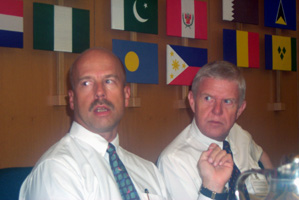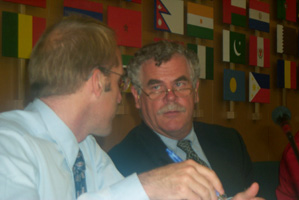|
|
|
|||||||||||||||||||||||||||||||||
Plenary: |
|
IMPLEMENTATION OF THE INTERIM PIC PROCEDURE |
|
| ADOPTION OF DECISION GUIDANCE DOCUMENTS: Regarding adoption of decision guidance documents for already identified chemicals (UNEP/FAO/PIC/INC.8/6), delegates discussed an Interim Chemical Review Committee (ICRC) recommendation to the INC that maleic hydrazide not be subject to the interim PIC procedure and that a decision guidance document not be developed, provided that identified manufacturers submit written confirmation by 1 January 2002 that the level of free hydrazine is not more than 1 ppm, and comply with the FAO specifications for the potassium salt of maleic hydrazide by 1 January 2004. | |
|
|
|
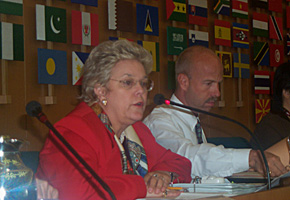 INC Chair Maria Celina de Azevedo Rodrigues (Brazil) (left) proposed that if these conditions were not met, the issue would be referred back to the ICRC. |
|
 The EU, NORWAY (left) and the US supported the Chair's proposal. |
|
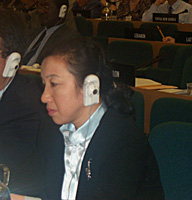 CHINA (right), supported by the REPUBLIC OF KOREA, said if the products were only used domestically, manufacturers should not be required to submit written confirmations. |
|
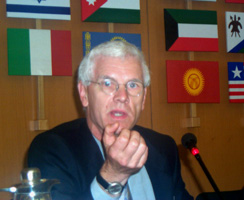 CONTAMINANTS: ICRC Chair Reiner Arndt (Germany) (left) introduced document UNEP/FAO/PIC/INC.8/7 on issues arising out of the second session of the ICRC. Regarding contaminants in industrial chemicals, delegates agreed that although the issue is important, it is not the highest priority, and recommended addressing it in future sessions of the ICRC once a notification of this nature has been submitted. |
|
| ISSUES ASSOCIATED WITH THE OPERATIONAL PROCEDURES FOR THE ICRC: On cooperation and coordination in the submission of notifications of final regulatory actions, Arndt noted that the ICRC recommended: updating and resubmitting notifications that do not satisfy the criteria of the interim procedure; calling upon designated national authorities and NGOs to help identify the scope of ongoing international trade in certain chemicals; and considering whether countries can provide updated scientific data to support old notifications. | |
|
INCLUSION
OF CHEMICALS IN THE INTERIM PIC PROCEDURE: Chair Rodrigues reported
that there are currently no chemicals that require inclusion in the
interim PIC procedure. |
|
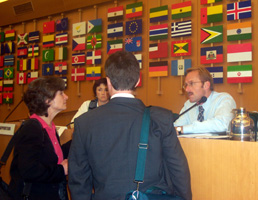 ANALYSIS OF PROBLEMS ENCOUNTERED BY PARTIES IN PREPARATION OF NOTIFICATIONS: Bill Murray (far right), interim Secretariat, presented the analysis of problems frequently encountered by Parties in preparing notifications of final regulatory actions (UNEP/FAO/PIC/INC.8/8), noting that 56 of 165 participating states have submitted notifications, and that of the 14 countries that have ratified the Convention, only five have submitted notifications. |
|
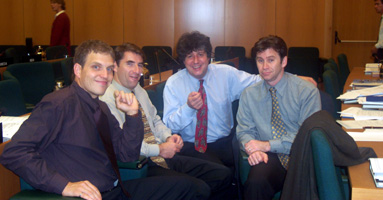 CANADA
suggested the Secretariat develop and distribute model forms. Many
delegations said it would be premature to change the form because the PIC
procedure is still in its infancy. Right photo: Members of the Canadian
delegation to PIC-8 CANADA
suggested the Secretariat develop and distribute model forms. Many
delegations said it would be premature to change the form because the PIC
procedure is still in its infancy. Right photo: Members of the Canadian
delegation to PIC-8
|
|
| SUBMISSION OF NOTIFICATIONS OF CHEMICALS ALREADY SUBJECT TO THE PIC PROCEDURE: | |
| Regarding submission of notifications of chemicals already subject to the PIC procedure and possible options to reconcile the need for information exchange with available resources (UNEP/FAO/PIC/INC.8/9), Bill Murray highlighted three options regarding submissions of final regulatory actions: continuation of submitting full notifications; a two-track approach depending on the scientific basis for the national regulatory action; and no obligation to submit a notification for Parties that have provided an import response. | |
|
|
|
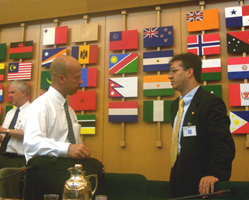 Chair Rodrigues said that the issue must be resolved at INC-8, proposed that further discussion be carried out in a working group, and asked Colombia to chair the group. Left photo L-R: Jim Willis in discussion with Gerardo Viña-Vizcaino (COLOMBIA). |
|
|
PREPARATION FOR THE COP DRAFT RULES OF PROCEDURE FOR THE COP: Jim Willis, Executive Secretary of the Rotterdam Convention, noted that outstanding issues had been carried forward from the INC-7 legal drafting group regarding draft rules on: dates of meetings; participation of other bodies or agencies; election of officers; quorum; majority required; and method of voting for general matters. He emphasized that these issues required resolution at INC-8. |
|
|
|
|
| ASSIGNMENT OF SPECIFIC HARMONIZED SYSTEM CUSTOMS CODES: | |
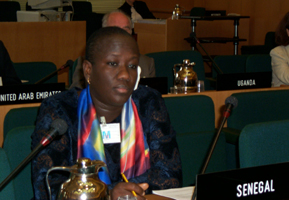 KENYA, NIGERIA and SENEGAL (left) called for capacity building of the customs officers and designated national authorities. |
|
| ISSUES ASSOCIATED WITH THE DISCONTINUATION OF THE INTERIM PIC PROCEDURE: | |
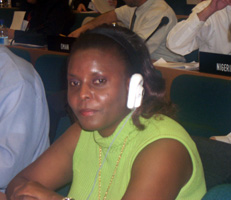 KENYA (right) said that since the Convention aims to foster broad participation, the working group should provide incentives to those experiencing difficulties ratifying the Convention. |
|
| DRAFT FINANCIAL RULES AND PROVISIONS: | |
 IRAN (left) suggested that delimitations on total contributions be subject to future negotiation. |
|
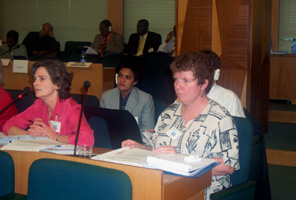 The US (right) suggested alternative assessment methodologies might be considered and stressed that no financial obligations are binding. |
|
|
|
|
| © 2001, IISD. All rights reserved. |
|


